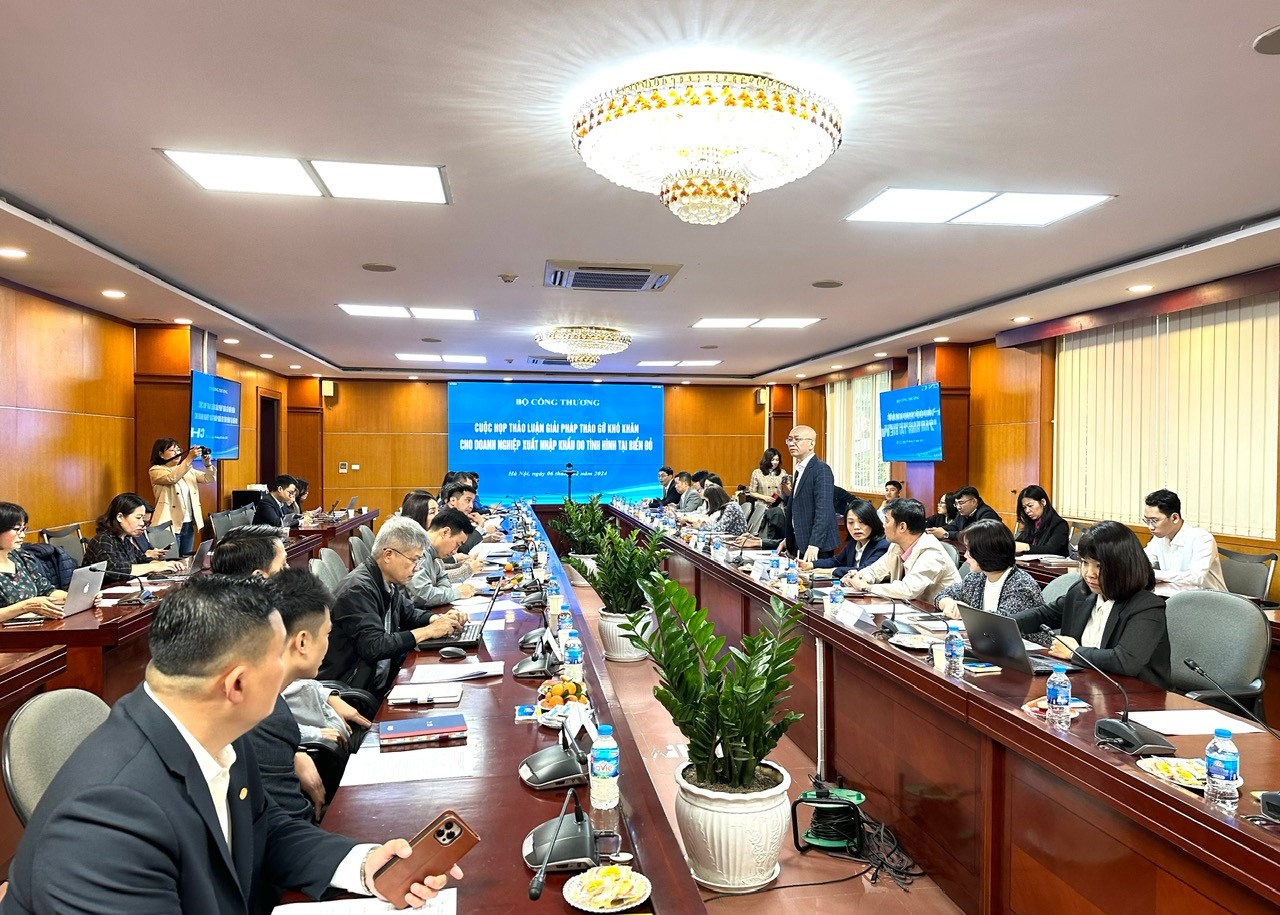On the morning of February 6 in Hanoi, the Ministry of Industry and Trade coordinated with the Ministry of Transport and the Ministry of Foreign Affairs to hold a meeting to discuss solutions to remove difficulties for import-export enterprises due to the situation in the Red Sea.

Speaking at the opening of the meeting, Mr. Tran Thanh Hai, Deputy Director of the Import-Export Department (Ministry of Industry and Trade), said that the Suez Canal is one of the strategic locations, connecting the Mediterranean Sea with the Red Sea.
The Red Sea and the Suez Canal provide a shortcut for ships to travel between European ports, the East Coast of the Americas to ports in South Asia, East Africa and Oceania. This is one of the most important maritime routes in the world, accounting for about 12% of total global maritime traffic.
However, since the end of 2023, due to conflicts in the Red Sea region, many shipping lines have had to change routes, not going through the Suez Canal but going around the Cape of Good Hope, making the ship's journey 10 to 15 days longer than before.
Along with restrictions on ships passing through the Panama Canal due to drought (El Nino), the latest developments in the Red Sea have had a negative impact on the world's shipping industry, as well as negatively affecting Vietnam's import and export activities, most directly with Europe and North America.
Faced with the above situation, since the end of December 2023, the Ministry of Industry and Trade has issued a document informing and recommending to associations, logistics service enterprises, as well as import-export enterprises a number of solutions to limit the impacts of the situation arising in the Red Sea region.
In 2023, Vietnam's total import-export turnover with Europe was 71.14 billion USD and with North America was 122.3 billion USD. The total import-export turnover of these two regions accounted for 28.4% of the total import-export turnover of the whole country in 2023. Therefore, it can be seen that the impact of the Red Sea conflict on Vietnam is not small.
Some of the immediate negative impacts include increased freight rates, more seriously the shortage of empty containers, longer transit times and the impact on the ability to meet import and export orders. Furthermore, the increase in freight costs and oil prices will have a domino effect on other commodity prices and increase economic and geopolitical instability, thereby hindering the global economic recovery.
At the meeting, managers, representatives of associations and directly related businesses updated and shared useful information; raised difficulties and problems that arose; made comments and assessments of the situation as well as proposed solutions, experiences and good practices to help Vietnamese businesses minimize negative impacts arising from conflicts in the Red Sea as well as exploit and take advantage of opportunities if any.

The American and European markets account for about 50% of Vietnam's total textile and garment export turnover. Mr. Truong Van Cam, Vice President and General Secretary of the Vietnam Textile and Apparel Association (VITAS), said that currently, businesses in the industry are implementing CIF import and FOB export, so there is not much immediate direct impact. Because for signed orders, manufacturing and exporting businesses are usually only responsible for the goods being loaded onto the ship. The next steps will be borne by shipping lines and customers.
However, when risks occur, there must be sharing, or in other words, customers will ask the seller to share certain things to reduce their losses. On the other hand, normally there are no sudden situations like this, customers have requested fast delivery, and when the shipping time is extended from 10 to 15 days, it leads to a shortened production time, putting pressure on manufacturing businesses to deliver on time.
“The most worrying thing is that it is unpredictable when the situation will end. If it continues, customers will definitely raise the issue of sharing additional shipping costs for subsequent orders. Therefore, what businesses are interested in is having early and timely information so that they can negotiate for subsequent orders to create initiative for businesses,” Mr. Truong Van Cam shared, and at the same time requested that shipping lines with additional surcharges, if any, or changes related to costs, need to be transparent, and provide early and timely information so that businesses can have directions to respond.
In the seafood sector, Mr. Nguyen Hoai Nam, Deputy General Secretary of the Vietnam Association of Seafood Exporters and Producers (VASEP), said that the Red Sea tension is a matter of concern for the business community, because in addition to the impact of increasing costs, there are also accompanying consequences. Notably, we do not know how long this situation will last. This affects future orders, or costs that businesses need to calculate into product prices.
In terms of the total cost of shipping a container of goods over the past month, shipping rates to the West Coast are up 70%, but those to Europe for frozen goods are up nearly fourfold. As with other industries, along with the difficulty of declining export orders, the Red Sea tensions are adding to the difficulties for the industries.
Appreciating the participation of 3 Ministries in organizing this meeting, Mr. Nguyen Hoai Nam also requested to receive more information. At the same time, he said that what export enterprises and State management agencies are most interested in is the cooperation, support, and active participation of shipping lines at this time, one of the important links in import-export activities.
“Most shipping lines are rerouting around the Cape of Good Hope, in the context that both imports and exports will decrease by 30-40% in 2023, which means shipping lines will cut down on mother ships. Combined with the Red Sea tensions, the transit time from Asia to Europe will be extended by 14 days, thus doubling the delay,” said Mr. Nguyen Hoai Nam.
In the agricultural sector, Ms. Hoang Thi Lien, President of the Vietnam Pepper and Spice Association, said that currently, this item is exported to the EU market accounting for 20%. In the future, Vietnam - EU trade relations will still focus on agricultural products, in which pepper and spice products have an absolute advantage. The Red Sea conflict has a low agricultural export value but is greatly affected.
“There are businesses that have loaded goods on ships since December 20, 2023, but by January 5, 2024, that is, 15 days after the shipping line has sailed, a surcharge of USD 2,000/40-foot container was applied. The arbitrary application of fees, without prior notice, without dialogue or agreement, puts exporters in a "fish on the chopping block" position," Ms. Hoang Thi Lien shared, saying that the behavior of shipping lines is not transparent, not public, and not appropriate.
Ms. Lien even said that if the business does not pay this additional surcharge, they will send an additional late payment surcharge, within 1 week if the surcharges (2,000 USD) requested by the shipping line are not paid, this makes the businesses even more frustrated. Currently, the shipping cost for this item to the EU market has increased 5-6 times. Therefore, the Vietnam Pepper and Spice Association proposed that there must be sanctions for shipping lines, not allowing shipping lines to arbitrarily increase or impose fees.
Regarding the application of surcharges by shipping lines, a representative of the Vietnam Maritime Administration said that currently, according to the provisions of Decree 146, shipping lines must publicly post freight rates as well as surcharges on the shipping line's website and notify customers. In case of changes or increases, they must notify 15 days in advance. If shipping lines immediately increase surcharges without notice, in any case where shipping lines apply them incorrectly, businesses must send a report to the Vietnam Maritime Administration. The Administration commits to properly handling cases where shipping lines and businesses violate the price posting regulations according to the law.
Currently, according to information from the Vietnam Maritime Administration, shipping rates are still high. From January 2024, shipping rates for containers by sea to the United States and Canada increased sharply compared to December 2023. Shipping rates to the West Coast increased from 1,850 USD/container in December 2023 to 2,873 - 2,950 USD/container in January 2024 (an increase of 55% - 60%); Shipping rates to the East Coast in December 2023 were at 2,600 USD/container, increasing to 4,100 - 4,500 USD/container in January 2024 (an increase of 58 - 73%).
Freight rates to Europe alone recorded a sharp increase compared to December 2023, with freight rates to Hamburg increasing from 1,200 - 1,300 USD in December 2023 to 4,350 - 4,450 USD in January 2024. European businesses are said to be most affected, as their supply chains are heavily dependent on the route through the Red Sea.
Real-time shipping data provided by the PortWatch platform - a joint initiative between the International Monetary Fund (IMF) and the University of Oxford - shows that the volume of goods passing through the Suez Canal (which connects the Red Sea to the Mediterranean Sea) in the province as of January 16, 2024 has decreased by 37%, while the volume passing through the Cape of Good Hope increased by 54% over the same period.
To respond to and minimize the negative impact of the Red Sea situation on import-export and freight transport activities related to Vietnamese enterprises, management agencies, associations and enterprises also proposed stabilizing freight rates and transportation fees; cargo flow and alternative routes; diversifying sources of goods supply; paying attention to negotiating sales contracts and insurance contracts closely following the situation; enhancing coordination, information exchange, situation assessment and response to similar situations in the future; enhancing international cooperation; developing prevention and rapid response plans.
Mr. Tran Thanh Hai affirmed that the Red Sea conflict is not a problem that one country can solve, and Vietnam cannot avoid being affected. However, by grasping information as quickly as possible, forecasting the impact as accurately as possible and taking appropriate response measures, we can aim to minimize the negative impacts of this global issue, and even turn “danger” into “opportunity” for some industries.
The Import-Export Department and co-chairing units as well as relevant ministries and branches will receive and study information and suggestions from the units, and at the same time monitor and closely follow the situation to advise leaders of relevant ministries and branches as well as report to higher levels to have necessary support solutions for businesses.
On the shipping lines side, Mr. Tran Thanh Hai suggested that in the current context, it is necessary to maintain routes and bring empty containers back to ensure import and export activities for Vietnamese enterprises. At the same time, it is necessary to properly implement regulations on listing, freight rates, and surcharges. Consider the possibility of having multimodal transport such as rail, sea and air. This requires the combination of many different transport units to overcome the impact of the Red Sea tension.
“Regarding the issue of fees that have not been listed or announced, we request that associations and industries report to the Vietnam Maritime Administration for handling,” said Mr. Tran Thanh Hai.
Associations and industries need to continue to closely monitor the situation, coordinate with ministries, sectors and logistics enterprises to support and help import-export enterprises in international trade activities. Import-export enterprises also need to closely monitor the situation and proactively respond.
Thu Trang/Tin Tuc Newspaper